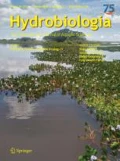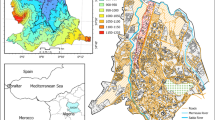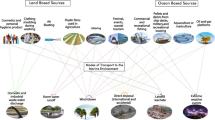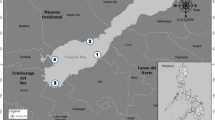Abstract
Reduced invertebrate abundance and diversity are common responses to metals contamination in mining-impacted streams. The resulting changes in community composition may have implications for metals accumulation and transfer through the food web. We investigated how changes in invertebrate community composition (abundance, species richness, and food web complexity) influence metals bioaccumulation and exposure risk to upper trophic levels along a contamination gradient in the upper Blackfoot River Basin, Montana. Invertebrate species richness exhibited the strongest decline with increasing sediment metals concentrations, driven by the loss of metals-sensitive taxa. These changes in invertebrate community composition resulted in a decline in the proportion of invertebrates in the scraper functional feeding group, likely influencing dietary metals exposure to the invertebrate community. Additionally, invertebrates with a strong propensity-to-drift increased with sediment contamination, potentially facilitating metals transfer to fish and higher trophic levels through predation. Using invertebrate exposure values (invertebrate abundance × metals concentrations), we found that moderately contaminated sites in our study area produced both the highest invertebrate exposure values and the highest fish tissue metals concentrations. Considering both changes in invertebrate community composition and metal concentrations is an important step towards understanding and evaluating potential toxic effects to upper trophic levels in mining-impacted streams.







Similar content being viewed by others
Data availability
All data generated or analyzed during this study are included in this published article or are available at the University of Montana ScholarWorks [https://scholarworks.umt.edu/geosci_data/2/] [Supplemental data files: Site_descriptions.csv, Site_map.pdf, Water_quality.csv, Fine_sediment_metals.csv, Fish_metals.csv, Fish_population.csv, Invertebrate_community_composition.csv, Invertebrate_metals.csv]
References
Akaike, H., 1973. Information theory as an extension of the maximum likelihood principle In Petrov, B., & F. Csaki (eds), Second international symposium on information theory. Akaemiai Kiado, Budapest: 267–281.
Allan, D. J., 1981. Determinants of diet of brook trout (Salvelinus fontinalis) in a mountain stream. Canadian Journal of Fisheries and Aquatic Sciences 38: 184–192.
August, E. E., D. M. McKnight, D. C. Hrncir & K. S. Garhart, 2002. Seasonal variability of metals transport through a wetland impacted by mine drainage in the Rocky Mountains. Environmental Science & Technology 36: 3779–3786.
Axtmann, E. V., D. J. Cain & S. N. Luoma, 1997. Effect of tributary inflows on the distribution of trace metals in fine- grained bed sediments and benthic insects of the Clark Fork River, Montana. Environmental Science and Technology 31: 750–758.
Beltman, D. J. B., W. H. Clements, J. Lipton & D. Cacela, 1999. Benthic invertebrate metals exposure, accumulation, and community-level effects downstream from a hard-rock mine site. Environmental Toxicology and Chemistry 18: 299–307.
Bersier, L. F., C. Banašek-Richter & M. F. Cattin, 2002. Quantitative descriptors of food-web matrices. Ecology 83: 2394–2407.
Besser, J. M., W. G. Brumbaugh, T. W. May, S. E. Church & B. A. Kimball, 2001. Bioavailability of metals in stream food webs and hazards to brook trout (Salvelinus fontinalis) in the upper Animas River watershed, Colorado. Archives of Environmental Contamination and Toxicology 40: 48–59.
Bureau of Land Management, 2014. Abandoned Mine Land Inventory Study for BLM-Managed Lands in California, Nevada, and Utah: site and feature analysis. Denver, CO.
Campbell, P. G. C., A. Hontela, J. B. Rasmussen, A. Giguère, A. Gravel, L. Kraemer, J. Kovesces, A. Lacroix, H. Levesque & G. Sherwood, 2003. Differentiating between direct (physiological) and food-chain mediated (bioenergetic) effects on fish in metal-impacted lakes. Human and Ecological Risk Assessment: An International Journal 9: 847–866.
Carlisle, D. M., 2001. Trophic structure and function of stream food webs along a gradient of metal contamination (Doctoral dissertation). Colorado State University.
Caton, L. W., 1991. Improved subsampling methods for the EPA “Rapid Bioassessment” benthic protocols. Bulletin of the North American Benthological Society of America 8: 317–319.
Clements, W. H., D. M. Carlisle, J. M. Lazorchak & P. C. Johnson, 2000. Heavy metals structure benthic communities in Colorado mountain streams. Ecological Applications 10: 626–638.
Clesceri, L. S., A. E. Greenberg & A. D. Eaton (eds), 1998. Standard methods for the examination of water and wastewater. Page 2-59, 20th ed. American Public Health Association, Washington, DC.
Croteau, M.-N., S. N. Luoma & A. R. Stewart, 2005. Trophic transfer of metals along freshwater food webs: evidence of cadmium biomagnification in nature. Limnology and Oceanography 50: 1511–1519.
Currie, R. S., W. L. Fairchild & D. C. G. Muir, 1997. Remobilization and export of cadmium from lake sediments by emerging insects. Environmental Toxicology and Chemistry 16: 2333–2338.
Erickson, R. J., D. R. Mount, T. L. Highland, J. R. Hockett, E. N. Leonard, V. R. Mattson, T. D. Dawson & K. G. Lott, 2010. Effects of copper, cadmium, lead, and arsenic in a live diet on juvenile fish growth. Canadian Journal of Fisheries and Aquatic Sciences 67: 1816–1826.
Erickson, R. J., D. R. Mount, T. L. Highland, J. R. Hockett & C. T. Jenson, 2011. The relative importance of waterborne and dietborne arsenic exposure on survival and growth of juvenile rainbow trout. Aquatic Toxicology 104: 108–115.
Farag, A. M., D. F. Woodward, J. N. Goldstein, W. Brumbaugh & J. S. Meyer, 1998. Concentrations of metals associated with mining waste in sediments, biofilm, benthic macroinvertebrates, and fish from the Coeur d’Alene River basin, Idaho. Archives of Environmental Contamination and Toxicology 34: 119–127.
Farag, A. M., D. A. Nimick, B. A. Kimball, S. E. Church, D. D. Harper & W. G. Brumbaugh, 2007. Concentrations of metals in water, sediment, biofilm, benthic macroinvertebrates, and fish in the Boulder River watershed, Montana, and the role of colloids in metal uptake. Archives of Environmental Contamination and Toxicology 52: 397–409.
Feldman, D., R. Bukantis, M. Mccarthy, & D. Kron, 2012. Sample collection, sorting, taxonomic identification, and analysis of benthic macroinvertebrate communities standard operating procedure. Montana Department of Environmental Quality.
Hansen, J. A., J. Lipton, P. G. Welsh, D. Cacela & B. MacConnell, 2009. Reduced growth of rainbow trout (Oncorhynchus mykiss) fed a live invertebrate diet pre-exposed to metal-contaminated sediments. Environmental Toxicology and Chemistry 23: 1902–1911.
Hogsden, K. L. & J. S. Harding, 2012. Consequences of acid mine drainage for the structure and function of benthic stream communities: a review. Freshwater Science 31: 108–120.
Jezierska, B. & M. Witeska, 2006. The metal uptake and accumulation in fish living in polluted waters. Soil and Water Pollution Monitoring, Protection and Remediation 3: 107–114.
Kraus, J. M., T. S. Schmidt, D. M. Walters, R. B. Wanty, R. E. Zuellig & R. E. Wolf, 2014. Cross-ecosystem impacts of stream pollution reduce resource and contaminant flux to riparian food webs. Ecological Applications 24: 235–243.
Langner, H., E. Greene, R. Domenech & M. Staats, 2012. Mercury and other mining-related contaminants in ospreys along the Upper Clark Fork River, Montana, USA. Archives of Environmental Contamination and Toxicology 62: 681–695.
Luoma, S. N., J. N. Moore, A. Farag, T. H. Hilman, D. J. Cain & M. Hornberger, 2008. Mining impacts on fish in the Clark Fork river, Montana: a field ecotoxicology case study. Page 1071. In Di Giulio, R. T. & D. E. Hinton (eds), Toxicology of Fishes. CRC Press, Boca Raton, FL.
MacDonald, D. D., C. G. Ingersoll & T. A. Berger, 2000. Development and evaluation of consensus-based sediment quality guidelines for freshwater ecosystems. Archives of Environmental Contamination and Toxicology 39: 20–31.
Mebane, C. A., R. J. Eakins, B. G. Fraser & W. J. Adams, 2015. Recovery of a mining-damaged stream ecosystem. Elementa: science of the Anthropocene 3: 42.
Menzie, C. A., 1980. Potential significance of insects in the removal of contaminants from aquatic systems. Water, Air, and Soil Pollution 13: 473–479.
Monna, F., E. Camizuli, P. Revelli, C. Biville, C. Thomas, R. Losno, R. Scheifler, O. Bruguier, S. Baron, C. Chateau, A. Ploquin & P. Alibert, 2011. Wild brown trout affected by historical mining in the Cevennes National Park, France. Environmental Science and Technology 45: 6823–6830.
Montana Department of Environmental Quality, 2016. Record of Decision. Final Cleanup for the Upper Blackfoot Mining Complex State Superfund Facility, Lewis and Clark County.
Montana Fish Wildlife and Parks, 1997. Effects of the June, 1975 Mike Horse Mine Tailings Dam failure on water quality and aquatic resources of the Upper Blackfoot River. Montana, Helena, MT.
Moore, J. N. & H. W. Langner, 2012. Can a river heal itself? Natural attenuation of metal contamination in river sediment. Environmental Science & Technology 46: 2616–2623.
Moore, J. N., S. N. Luoma & D. Peters, 1991. Downstream effects of mine effluent on an intermontane riparian system. Canadian Journal of Fisheries and Aquatic Sciences 48: 222–232.
Nagorski, S. A., J. N. Moore & D. B. Smith, 2002a. Distribution of Metals in Water and Bed Sediment in a Mineral-Rich Watershed, Montana, USA. Mine Water and the Environment 21: 121–136.
Nagorski, S. A., J. N. Moore & D. B. Smith, 2002b. Distribution of metals in water and bed sediment in a mineral-rich watershed, Montana, USA. Mine Water and the Environment 21: 121–136.
Nakano, S., K. D. Fausch, T. Furukawa-Tanaka, K. Maekawa & H. Kawanabe, 1992. Resource utilization by bull char and cutthroat trout in a mountain stream in Montana, U.S.A. Japanese Journal of Ichthyology 39: 211–217.
Newman, R. M., 1987. Comparison of encounter model predictions with observed size-selectivity by stream trout. Journal of North American Benthological Society 6: 56–64.
Poff, N. L., J. D. Olden, N. K. M. Vieira, D. S. Finn, M. P. Simmons & B. C. Kondratieff, 2006. Functional trait niches of North American lotic insects: traits-based ecological applications in light of phylogenetic relationships. Journal of the North American Benthological Society 25: 730–755.
Poulton, B. C., D. P. Monda, D. F. Woodward, M. L. Wildhaber & W. G. Brumbaugh, 1995. Relations between benthic community structure and metals concentrations in aquatic macroinvertebrates: Clark Fork River, Montana. Journal of Freshwater Ecology 10: 277–293.
Quinn, M. R., X. Feng, C. L. Folt & C. P. Chamberlain, 2003. Analyzing trophic transfer of metals in stream food webs using nitrogen isotopes. Science of the Total Environment 317: 73–89.
R Core Team, 2015. R: A Language and Environment for Statistical Computing. R Foundation for Statistical Computing, https://www.r-project.org/.
Rader, R. B., 1997. A functional classification of the drift: traits that influence invertebrate availability to salmonids. Canadian Journal of Fisheries and Aquatic Sciences 54: 1211–1234.
Schemel, L. E., B. A. Kimball & K. E. Bencala, 2000. Colloid formation and metal transport through two mixing zones affected by acid mine drainage near Silverton, Colorado. Applied Geochemistry 15: 1003–1018.
Schmitz, D., J. Mason, M. Blank, & J. Cahoon, 2010. Channel response assessment for the upper Blackfoot River. Montana Department of Natural Resources and Conservation 1–46.
Shelton, L. R., & P. D. Capel, 1994. Guidelines for collecting and processing samples of stream bed sediment for analysis of trace elements and organic contaminants for the National Water-Quality Assessment Program. US Geological Survey Open-File Report 94–458, Sacramento, California.
Song, J., X. Yang, J. Zhang, Y. Long, Y. Zhang & T. Zhang, 2015. Assessing the variability of heavy metal concentrations in liquid-solid two-phase and related environmental risks in the Weihe River of Shaanxi Province, China. International Journal of Environmental Research and Public Health 12: 8243–8262.
U.S. Environmental Protection Agency, 1991. Methods for the determination of metals in environmental samples. Washington, DC.
U.S. Environmental Protection Agency, 2007. Aquatic Life Ambient Freshwater Quality Criteria – Copper. Washington, DC.
U.S. Environmental Protection Agency, 2016. Aquatic Life Ambient Water Quality Criteria – Cadmium. Washington, DC.
U.S. Fish and Wildlife Service, 1993. Milltown endangerment assessment project: effects of metal-contaminated sediment, water, and diet on aquatic organisms. National Fisheries Contaminant Research Center, Columbia, MO.
Vandeberg, G. S., C. W. Martin & G. M. Pierzynski, 2011. Spatial distribution of trace elements in floodplain alluvium of the upper Blackfoot River, Montana. Environmental Earth Sciences 62: 1521–1534.
Ward, J. V. & B. C. Kondratieff, 1992. An illustrated guide to the mountain stream insects of Colorado. University Press of Colorado, Fort Collins.
Wolman, G. M., 1954. A method of sampling coarse river-bed material. Transactions of the American Geophysical Union 35: 951–956.
Woodward, D. F., W. G. Brumbaugh, A. J. Lelonay, E. E. Little & C. Smith, 1994. Effects on rainbow trout fry of a metals-contaminated diet of benthic invertebrates from the Clark Fork River, Montana. Transactions of the American Fisheries Society 123: 51–62.
Acknowledgements
This research was funded by the US Environmental Protection Agency and the US Forest Service. We thank Nick Hehemann, Robert Livesay, Doug Brinkerhoff, and Matt Corsi for field data collection and Johnnie Moore for guidance. We also thank Will Clements and anonymous reviewers for comments that greatly improved the manuscript.
Author information
Authors and Affiliations
Corresponding author
Additional information
Handling editor: Checo Colón-Gaud
Electronic supplementary material
Below is the link to the electronic supplementary material.
Rights and permissions
About this article
Cite this article
Landers, J., Sullivan, S., Eby, L. et al. Metal contamination and food web changes alter exposure to upper trophic levels in upper Blackfoot River basin streams, Montana. Hydrobiologia 830, 93–113 (2019). https://doi.org/10.1007/s10750-018-3857-8
Received:
Revised:
Accepted:
Published:
Issue Date:
DOI: https://doi.org/10.1007/s10750-018-3857-8




